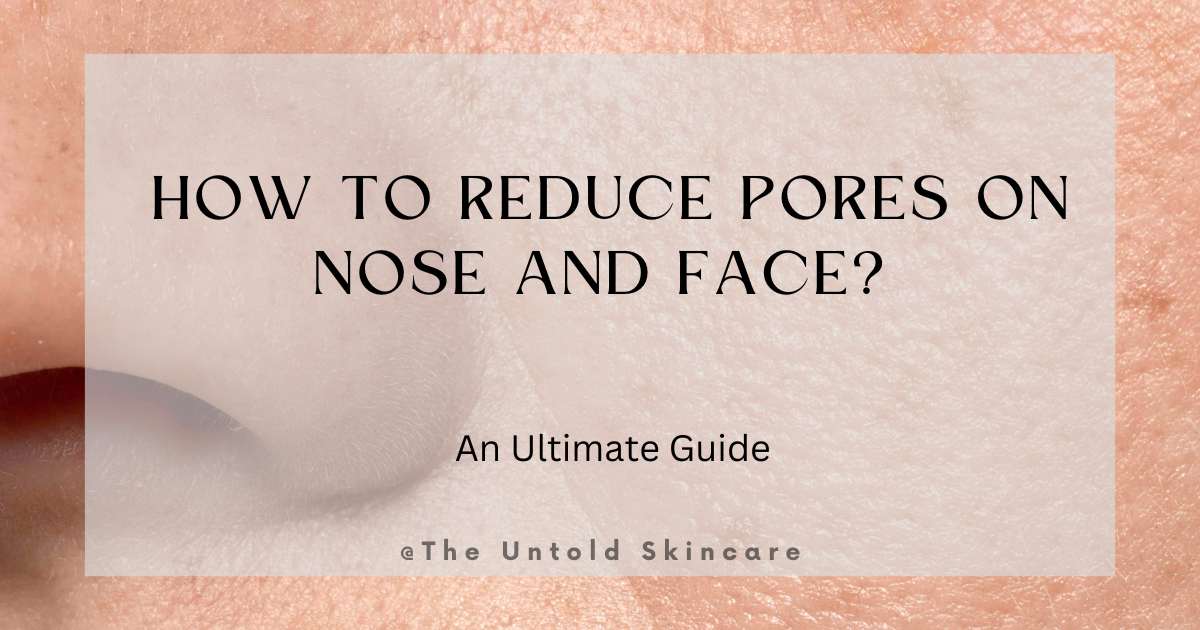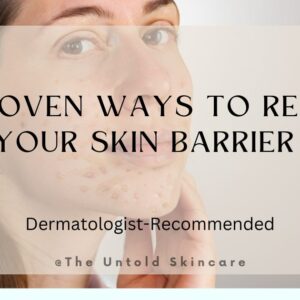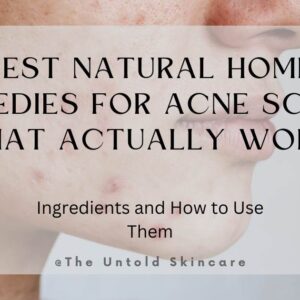Have you ever looked in the mirror and felt frustrated by the size of your pores? If yes, you’re not alone.
Large pores are a common concern, especially for those with oily or combination skin.
The good news? While you can’t make them disappear completely, you can make them look smaller with the right measures.
In this post, I will be sharing with you everything you’ll ever need about facial pores and how you can reduce their size.
Everything you read in this post is purely science-based and backed by scientific research, carefully curated from clinical studies, dermatological research, and expert-backed findings. All the information, facts, and solution measures mentioned in this post are taken from multiple research papers, articles, and other trusted sources.
So, if you’re tired of using filters in your photos and want smooth, refined skin in real life, keep reading, because this is the guide you’ve been looking for. Now, let’s start.
Understanding Pores
Pores are tiny openings in the skin that play a crucial role in maintaining its health and function. They act as gateways for sweat and sebum, helping regulate body temperature and keeping the skin moisturized.
Each pore is connected to a hair follicle and a sebaceous gland, which produces oil to prevent dryness and protect against environmental damage. Without pores, our skin wouldn’t be able to release toxins, stay hydrated, or defend itself from harmful bacteria.
Although often seen as a huge skin concern, pores are essential for skin health. They naturally allow the skin to breathe and function properly. However, several factors can make them stretched and appear larger, making pores look more prominent.
And the problem is that a larger pore doesn’t look good.
Factors Influencing Pores Size
Several factors influence the size of your pores, and while some are beyond your control, many can be managed with the right approach. Here are some of the major factors influencing the facial pore size:
Excess Sebum Production
Excess sebum production is unarguably the major contributor to enlarged pores.
Sebum, an oily substance produced by sebaceous glands, plays a vital role in moisturizing the skin and protecting it from external elements. However, when sebum production exceeds the skin’s needs, it can clog the pores.
This accumulation of oil, along with dead skin cells, debris, and bacteria, leads to the formation of a plug that expands the pore’s size. Over time, this repeated process results in pores appearing more dilated.
So, Oily skin types are especially prone to larger pores due to increased sebum secretion.
Related Post: How to Reduce Sebum Production? A Comprehensive Guide
Decreased Skin Elasticity
Skin elasticity refers to the skin’s ability to stretch and return to its original shape. This property is directly linked to the tightness of the skin, which impacts the appearance of pores.
When the skin loses its elasticity, the supportive structure around the pores weakens. This loss of structural support makes the skin less resilient, causing it to sag and loosen.
As a result, pores no longer have the tight, firm support they once did and expand in size.
Related Post: How to Increase Elasticity in Skin Naturally? 6 Simple Ways
Increased Hair Follicle Volume
Each pore on your face is actually a hair follicle. Therefore, the size of the hair follicle significantly influences pore size.
When hair follicles become larger, their diameter increases, which directly correlates to the increased size of the pore. Increased hair follicle volume can occur due to factors like genetics, hormonal fluctuations, and certain skin conditions.
Additionally, the presence of a thick or coarse hair strand in the follicle can expand the pore, as the hair follicle accommodates both the hair and the surrounding oil and debris. Over time, this increased volume leads to more noticeable pores on the skin’s surface.
Chronic Recurrent Acne
Acne, particularly in its more severe and chronic forms, can contribute significantly to enlarged pores.
Acne occurs when the hair follicles become clogged with a mixture of sebum, dead skin cells, and bacteria, leading to inflammation and infection. In cases of recurrent acne, the repeated process of pore blockage and inflammation causes long-term damage to the pore structure.
The inflammation weakens the surrounding skin tissue and collagen, leading to the expansion of the pore. Additionally, acne scars and the healing process often result in changes to skin texture, which can make pores appear even larger.
Chronic acne, therefore, not only affects the pores temporarily but can also cause permanent enlargement if left untreated over time.
Genetic Factors
Genetics play a significant role in determining the natural size of your pores. If you inherit traits from your parents that favor larger pores, such as increased sebaceous gland activity or thicker skin, you’re more likely to experience noticeable pores.
Genetic factors can also influence skin type, and individuals with oily or thick skin are more prone to having enlarged pores. These hereditary characteristics often manifest during puberty when hormonal fluctuations lead to an increase in oil production. While you can’t change your genetic predisposition, understanding its influence allows you to manage your skin more effectively by adopting targeted skincare practices.
How to Reduce Pore Size?
While you can’t completely erase pores (they’re essential for healthy skin), you can make them look tighter, cleaner, and less noticeable. Here’s how you can refine your pores and achieve smoother-looking skin.
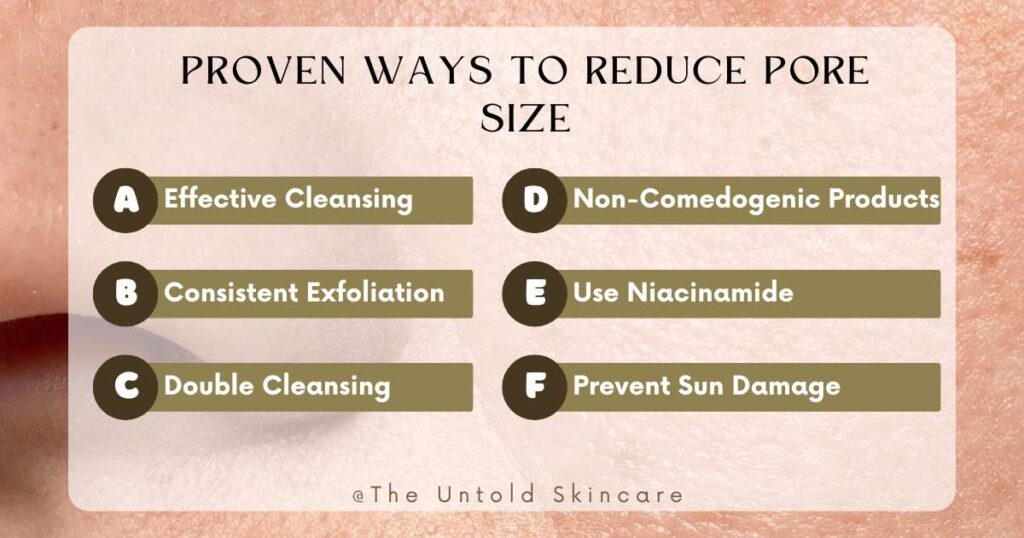
An Effective Cleansing Routine
Reducing the appearance of large pores starts with a proper cleansing routine. When oil, dirt, and dead skin cells accumulate, they clog pores and make them appear larger. Cleansing your face twice a day—morning and night—is essential. Choose a gentle cleanser that suits your skin type and stick to it consistently.

For those with oily or acne-prone skin, opt for cleansers with active ingredients like salicylic acid or glycolic acid. These help dissolve pore-clogging debris and refine skin texture.
According to a study published in the Journal of Clinical and Aesthetic Dermatology, regular use of salicylic acid significantly improved pore visibility and overall skin clarity. Keep your routine consistent and don’t underestimate the power of a clean face.
Related Post: How to Wash Your Face Properly?
Consistent Exfoliation
Exfoliation is an absolute game-changer when it comes to minimizing pores. It removes the layer of dead skin cells that can block pores and stretches them out. This helps keep the skin surface smooth and prevents buildup that leads to enlarged pores.

Avoid physical exfoliants and always consider chemical exfoliants like AHAs (alpha hydroxy acids) and BHAs (beta hydroxy acids). They work below the surface and clean pores from the inside out.
Dermatologists recommend exfoliating 2 to 3 times a week, depending on your skin type and sensitivity. Over-exfoliating can cause irritation and disrupt the skin’s natural barrier, which might actually make pores more noticeable.
Double Cleansing
Double cleansing is a skincare method that involves using an oil-based cleanser followed by a water-based cleanser. This technique ensures a thorough removal of oil-based impurities like sunscreen, makeup, and excess sebum, which can contribute to clogged and enlarged pores.
The second cleanse, with a water-based product, targets water-based debris such as sweat and environmental pollutants. This two-step method originated in Korea and has been a cornerstone of K-beauty routines aimed at refining pores and enhancing skin clarity.
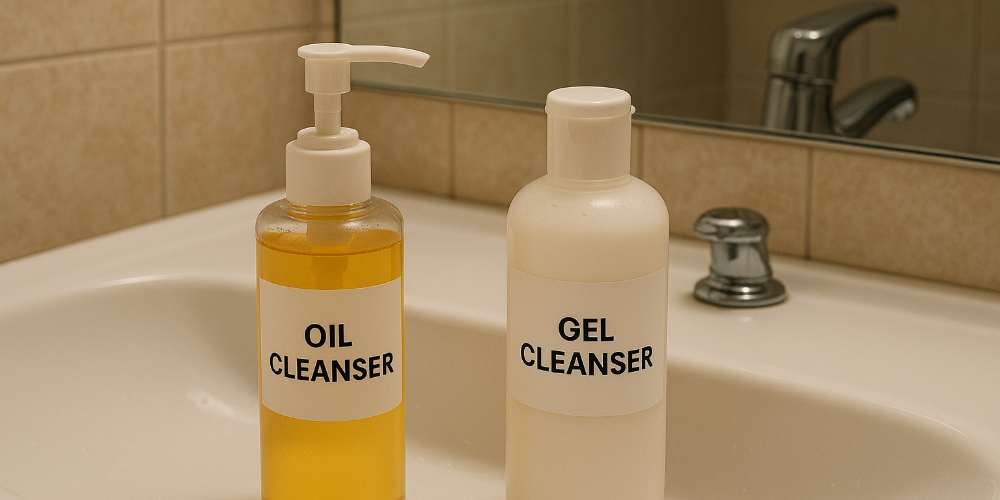
Studies have shown that improper cleansing can leave up to 30% of makeup residue on the skin even after one wash, contributing to clogged pores and breakouts. Double cleansing addresses this issue effectively. A 2020 study published in Skin Research and Technology demonstrated that individuals who practiced double cleansing for four weeks reported noticeable reductions in skin congestion, blackheads, and visible pore size.
Add this habit to your nighttime routine and see the magic happen in less than a month.
Use Non-Comedogenic Products
Non-comedogenic products are specifically formulated not to clog pores. This includes makeup, moisturizers, sunscreens, and even certain haircare products. Ingredients like heavy oils, silicones, or lanolin derivatives are known to block pores and should be avoided by individuals prone to enlarged pores or breakouts.
By switching to non-comedogenic formulations, you can prevent the buildup that leads to stretched, inflamed, and congested pores.
The term “non-comedogenic” is not always regulated, so it’s wise to read labels carefully and look for products tested by dermatologists. Studies have validated that switching to a 100% non-comedogenic skincare regimen for upto eight weekscan give a 20% reduction in pore size and a 34% decrease in acne lesions.
So, always look for the label “Non-Comedogenic” on every skincare product you use.
Use Niacinamide
Niacinamide, also known as vitamin B3, is a powerhouse ingredient for improving skin texture and minimizing pores. It works by regulating sebum production, which prevents the pores from becoming stretched by excess oil.

Niacinamide also has anti-inflammatory and antioxidant properties, helping to reduce skin redness and reinforce the skin’s barrier. This results in smoother skin and tighter-looking pores.
For best results, look for formulations with 5–10% niacinamide and apply once or twice daily, ideally after cleansing and before moisturizing.
Protect Skin from Sun Damage
Sun exposure is one of the most overlooked contributors to enlarged pores. UV rays break down collagen and elastin, key proteins responsible for keeping the skin firm and supple. As the skin loses elasticity, pores appear more dilated.

Wearing sunscreen daily is crucial not just for preventing sunburn and skin cancer, but also for maintaining smooth, poreless-looking skin. Broad-spectrum sunscreens that protect against both UVA and UVB rays are ideal.
Using a non-comedogenic sunscreen with at least SPF 30 can make a notable difference in pore size over time. Don’t forget to reapply sunscreen every 2 hours when exposed to direct sunlight, and consider wearing hats or seeking shade to further protect the skin.
Also Read: How to Get Clear Skin? 20 Tips That Include Everything
Frequently Asked Questions
1. Can I permanently shrink my pores?
No, pore size is genetically determined. However, consistent skincare can make them appear smaller.
2. Do pores open and close?
Pores don’t have muscles to open or close. Treatments can make them appear less noticeable but can’t change their actual size.
3. Are pore strips effective?
Pore strips can remove surface debris but don’t provide long-term pore size reduction.
4. How does diet impact pore size?
A balanced diet supports overall skin health, but there’s limited evidence linking specific foods to pore size.
5. Can oily skin make pores look bigger?
Yes, excess oil can stretch out pores and make them appear larger. Controlling oil production helps reduce their visibility.
6. Is exfoliation safe for sensitive skin?
Yes, but choose gentle chemical exfoliants like lactic acid and use them less frequently—once a week is a good start.
7. Does aging affect pore size?
Yes, as collagen and elastin break down with age, skin loses firmness and pores may look more pronounced.
8. Can makeup make pores worse?
Yes, especially if it’s comedogenic or not removed properly. Always choose non-comedogenic makeup and double cleanse at night.
9. Do cold water or ice close pores?
No, cold water or ice may temporarily tighten skin, but they don’t physically close pores. The effect is only short-term.

